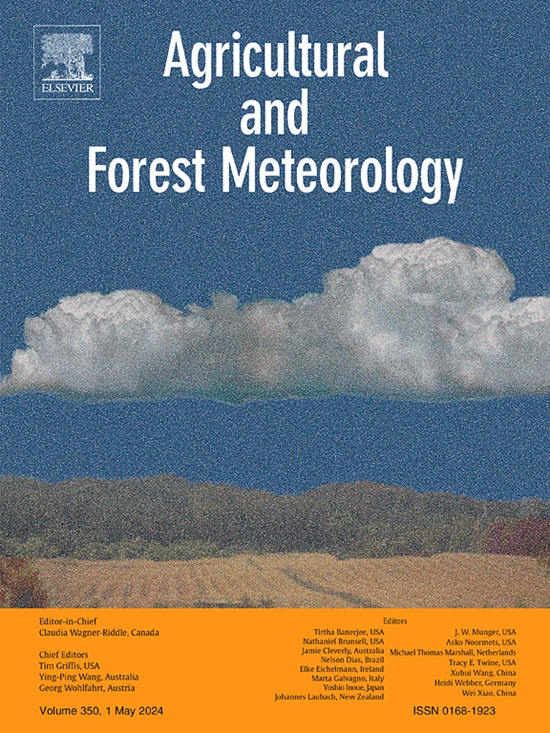高需水量限制了中国西南地区特大干旱期间高大森林的碳汇和蒸腾作用
IF 5.6
1区 农林科学
Q1 AGRONOMY
引用次数: 0
摘要
随着气候变暖,与干旱相关的森林死亡率或枯死率正在上升。以往的研究表明,冠层高度是影响干旱条件下森林生存和生长的重要因素之一,但这种冠层高度依赖的机制尚不清楚。基于标准化降水蒸散发指数(SPEI)、总初级生产力(GPP)和植被蒸腾数据,采用线性回归(LR)和随机森林(RF)模型,探讨了2010年中国西南地区极端干旱林冠高度对森林碳水循环的影响。结果表明,无论何种森林类型,GPP和蒸腾的下降不仅与干旱强度有关,还与冠层高度有关。高大的森林(>;30 m)的GPP和蒸腾损失比矮林(<;增加的干旱强度会改善这种冠层高度依赖性,特别是在极端干旱条件下(SPEI <;−2)。关于冠层高度对森林水循环的影响,冠层高度与SPEI和蒸腾均有相关性(p <;0.001),这意味着高大的森林需要更多的水来维持生长。这些结果揭示了森林抗旱性由冠层高度区分的原因,对森林动态研究和管理具有广泛的指导意义。本文章由计算机程序翻译,如有差异,请以英文原文为准。
High water demand limits carbon sink and transpiration in tall forests during extreme drought in Southwest China
Drought-related forest mortality or dieback is increasing with climate warming. Previous studies have showed canopy height was one of the most important factors that related to forest survival and growth under drought, but the mechanism of this canopy height-dependency is still unclear. Based on standardized precipitation evapotranspiration index (SPEI) data, gross primary productivity (GPP) data and vegetation transpiration data, we use linear regression (LR) and random forest (RF) model to explored the impact of canopy height on forest carbon and water cycle in southwestern China for the 2010 extreme drought. Regardless of forest types, the results showed that the decline of GPP and transpiration were not only related to drought intensity but also depend on canopy height. Tall forest (> 30 m) would lose more GPP and transpiration than short forest (< 20 m), and the increasing drought intensities would improve this canopy height-dependency, especially under extreme drought condition (SPEI < −2). Regarding how canopy height affects forest water cycle, the canopy height has correlation with both SPEI and transpiration (p < 0.001) which mean tall forest needs more water to maintain growth. These results explore the reason why forest drought resistance distinguishing by canopy height, which may have a broad range implication in forest dynamics research and management.
求助全文
通过发布文献求助,成功后即可免费获取论文全文。
去求助
来源期刊
CiteScore
10.30
自引率
9.70%
发文量
415
审稿时长
69 days
期刊介绍:
Agricultural and Forest Meteorology is an international journal for the publication of original articles and reviews on the inter-relationship between meteorology, agriculture, forestry, and natural ecosystems. Emphasis is on basic and applied scientific research relevant to practical problems in the field of plant and soil sciences, ecology and biogeochemistry as affected by weather as well as climate variability and change. Theoretical models should be tested against experimental data. Articles must appeal to an international audience. Special issues devoted to single topics are also published.
Typical topics include canopy micrometeorology (e.g. canopy radiation transfer, turbulence near the ground, evapotranspiration, energy balance, fluxes of trace gases), micrometeorological instrumentation (e.g., sensors for trace gases, flux measurement instruments, radiation measurement techniques), aerobiology (e.g. the dispersion of pollen, spores, insects and pesticides), biometeorology (e.g. the effect of weather and climate on plant distribution, crop yield, water-use efficiency, and plant phenology), forest-fire/weather interactions, and feedbacks from vegetation to weather and the climate system.

 求助内容:
求助内容: 应助结果提醒方式:
应助结果提醒方式:


